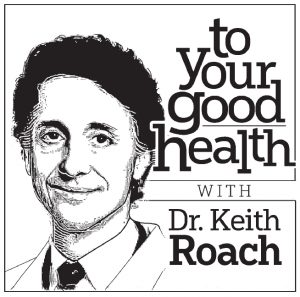TO YOUR GOOD HEALTH: Is Big and Tall Patient Getting Petite-Size Meds?
By Keith Roach, M.D. — January 31, 2019 DEAR DR. ROACH: I am 71 years old, stand 6 feet, 5 inches tall and weigh 325 pounds. The “average” person is half my size, yet when I get medication for various ailments (e.g., gout, pain, flu shots, etc.) I get the standard dose. I assume I have more physical mass as well as a larger blood supply, which leads me to the conclusion that I am receiving a smaller concentration of medicine than the typical patient. Am I correct? — M.K.
DEAR DR. ROACH: I am 71 years old, stand 6 feet, 5 inches tall and weigh 325 pounds. The “average” person is half my size, yet when I get medication for various ailments (e.g., gout, pain, flu shots, etc.) I get the standard dose. I assume I have more physical mass as well as a larger blood supply, which leads me to the conclusion that I am receiving a smaller concentration of medicine than the typical patient. Am I correct? — M.K.
ANSWER: All medicines have concentrations at which they work optimally. Too low a dose and they aren’t effective, and too high a dose increases risk of toxicity. Some drugs have a very small range that’s both effective and nontoxic, and these are referred to as having a “narrow toxic to therapeutic ratio.” Others have a very large range where they are effective and nontoxic, such as most over-the-counter pain medicines and flu shots.
Penicillin has a very wide toxic to therapeutic ratio, but I use that example precisely because some people will have an allergic reaction. There is no drug — prescribed, over-the-counter or supplement — that is either perfectly safe while being effective, or perfectly effective while being safe, for every person.
The concentration of the drug in the appropriate area of the body (sometimes blood, sometimes the affected organ, sometimes urine) may depend on the dose as well as your characteristics. Despite being much larger than average, your blood volume is probably only a little above the average, since the increased bone mass, muscle mass and, in most people your size, fat mass are disproportionate to the blood. Some medicines go to the blood, others to “lean body mass” and still others preferentially to fat.
So while you are correct that you are getting a smaller concentration of medicine, that’s still OK most of the time. For medications that need to be dosed precisely, those with a narrow toxic to therapeutic ratio (such as some antibiotics, heart medication and chemotherapy), the dosing is based on height, weight, age and sometimes kidney and liver function.
******
DEAR DR. ROACH: I am 80 years old, in good health with no cancer in the family. Up to now, I have always had regular Pap smears and mammograms. Now I am aware that there are different thoughts as to whether those tests are needed at my age. What is your advice? — J.G.
ANSWER: For Pap smears, there is very good evidence that women who have never had any problems with their Pap smears by age 65 are very unlikely to ever develop any, and I agree with the recommendation by the U.S. Preventive Services Task Force to stop them at age 65.
Mammograms are more controversial, but my personal practice is to continue to recommend them for most women until about age 75. I stop recommending mammograms to women when they have an underlying medical condition that makes it unlikely that they will receive benefit from continued screening. Deciding when that is takes some experience and a lot of discussion with the patient and sometimes her family. There is no absolute age cutoff for mammograms, and getting a mammogram on a healthy 80-year-old might make sense. Getting a mammogram on a woman with incurable lung cancer, for example, does not.
******
Dr. Roach regrets that he is unable to answer individual letters, but will incorporate them in the column whenever possible. Readers may email questions to ToYourGoodHealth@med.cornell.edu.
© 2019 North America Synd., Inc.
All Rights Reserved
—TO YOUR GOOD HEALTH: Is Big and Tall Patient Getting Petite-Size Meds?–



